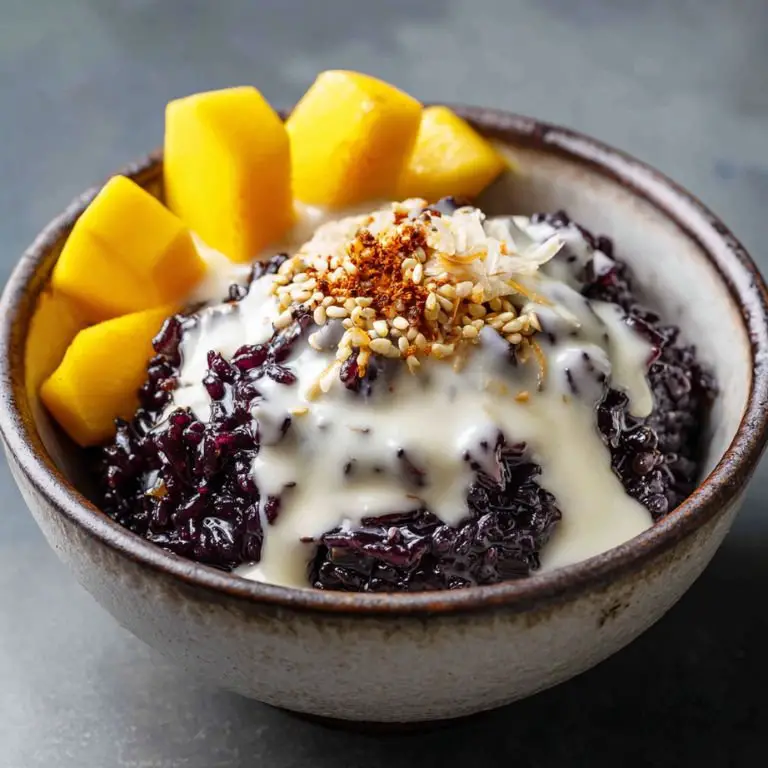Thai black sticky rice pudding with pandan and coconut is one of those desserts that quietly steals the show. While many people rave about the more well-known thai mango sticky rice, this deep, nutty, and fragrant pudding offers a different kind of indulgence—one that’s slightly earthy, creamy, and naturally sweet. With the distinct aroma of pandan and the richness of coconut milk, it’s a soul-warming dish that feels at home whether you’re making it for an after-dinner treat or preparing it in advance for a small gathering. If you're diving into easy Thai recipes or looking for something new beyond the usual easy pad thai recipe or thai fried rice recipe authentic style, this is a delicious place to start.
Thai Black Sticky Rice Pudding with Pandan and Coconut
Prep Time 10 minutes mins
Cook Time 1 hour hr
Total Time 1 hour hr 10 minutes mins
Course Dessert
Cuisine Thai
Medium Saucepan with Lid For simmering the sticky rice.
Fine mesh strainer To rinse the rice thoroughly.
Wooden spoon or silicone spatula For stirring during cooking.
Small saucepan For making the coconut topping.
Serving bowls or cups Small glass cups or ramekins work beautifully for individual servings.
For the pudding
- 1 cup Thai black sticky rice also labeled as black glutinous rice
- 3 cups water
- 1/2 teaspoon salt
- 3/4 cup coconut milk full-fat
- 1/3 cup palm sugar or substitute with dark brown sugar
- 2-3 pandan leaves tied into a knot (or 1/2 teaspoon pandan extract)
For the coconut topping
- 1/2 cup coconut milk
- 1 tablespoon sugar
- 1/8 teaspoon salt
- 1 teaspoon cornstarch optional, for thickening
Optional toppings
- Toasted sesame seeds
- Fresh chopped mang
- Toasted shredded coconut
- Crushed peanuts or mung beans
Step 1: Rinse the Rice Thoroughly
Start by rinsing the black sticky rice under cold water in a fine mesh sieve. You’ll want to do this several times until the water runs mostly clear. This helps remove excess starch and prevents the pudding from getting gummy.
Step 2: Simmer with Pandan
In a medium saucepan, combine the rinsed sticky rice, 3 cups of water, and the knotted pandan leaves. Bring to a boil over medium-high heat. Once it starts bubbling, reduce to a simmer, cover, and cook for about 45 minutes, stirring occasionally to prevent sticking. The rice should be tender but still have some chew, and the water mostly absorbed.
Step 3: Add Coconut Milk and Sugar
Remove the pandan leaves. Stir in 3/4 cup coconut milk, palm sugar, and 1/2 teaspoon salt. Continue simmering, uncovered, for another 10–15 minutes, stirring frequently until the mixture becomes thick and creamy. Taste and adjust the sweetness if needed.
Step 4: Make the Coconut Topping
In a small saucepan, combine the 1/2 cup coconut milk, sugar, and salt. Heat gently over low heat until warmed through. If you prefer a thicker topping, mix a teaspoon of cornstarch with a tablespoon of water and stir it in. Cook for another minute until slightly thickened, then remove from heat.
Step 5: Assemble and Serve
Spoon the warm black sticky rice pudding into bowls. Drizzle with the sweet coconut topping and sprinkle with toasted sesame seeds or shredded coconut. You can also serve it with fresh mango slices for a twist on the classic thai sweet sticky rice with mango or easy mango sticky rice. Serve warm or at room temperature.
Pairings
This dessert shines on its own, but it also pairs beautifully with other Thai dishes, especially if you’re serving it as part of a larger meal. Here are some pairing ideas:
- After a savory Thai dish: Serve after a spicy thai rice noodle recipe or thai dishes like larb or tom yum to balance out the heat.
- With mango or tropical fruit: This is a great alternative or complement to traditional mango sticky rice and can be served side by side with it for variety.
- Alongside Thai tea or iced coffee: The bitterness of Thai tea or a strong Thai-style iced coffee contrasts beautifully with the sweet, nutty pudding.
- As a brunch dessert: Pair it with a light fruit salad or even sticky rice cakes for a fun brunch spread with Southeast Asian flair.
FAQs
1. What type of rice should I use for black sticky rice pudding?
You’ll need Thai black sticky rice, also called black glutinous rice. It’s different from wild rice or Chinese black rice and has a naturally sweet, nutty flavor. It's similar in texture to what you’d find in chinese sticky rice or other sweet sticky rice recipes.
2. Can I make this pudding with white sticky rice instead?
Technically yes, but you’ll lose the earthy depth and gorgeous purple-black hue that makes this pudding unique. White sticky rice is more common in thai coconut rice or sweet sticky rice with mango, but this version leans into the rustic richness of black sticky rice.
3. How do I store and reheat leftovers?
Store leftovers in an airtight container in the fridge for up to 3 days. Reheat gently on the stove or in the microwave with a splash of water or coconut milk to loosen it up. It thickens as it sits.
4. Is pandan necessary?
Pandan adds a unique floral aroma that elevates this dish, but if you can't find it fresh or frozen, pandan extract is a great substitute. If you skip it entirely, the dish will still be good—just missing that signature Thai fragrance.
5. Can I serve this cold?
Yes! While traditionally served warm or at room temperature, it’s also lovely chilled—especially on a hot day. Just note that the texture firms up when cold, so you may want to loosen it with a bit of coconut milk before serving.
